Software Development, Finance and AI
We’ve been doing Software Development and Architecture work for a while at Snowpal, and currently have several B2B and B2C products in production. In this podcast, we’ll share our experiences on a regular basis to help you & your teams build great software. The topics covered in this podcast will include Product Management, Project Management, Architecture, Development, Deployment, Security, Release Management, Sales, Marketing, Advertising, and just about everything else an ambitious, fast growing startup based out of the US is likely to be involved in. So, join us. Let’s become better!
Episodes

Monday Oct 28, 2024
Fixing numerous android build errors
Monday Oct 28, 2024
Monday Oct 28, 2024
In this episode, Krish Palaniappan discusses the challenges faced while resolving Android build errors related to Flutter. He shares insights on identifying core issues, managing dependencies, and implementing effective solutions to overcome these technical hurdles. The conversation aims to provide listeners with practical advice to save time and effort when encountering similar problems.
Takeaways
Incompatibility between different versions often leads to build issues.
Community solutions may not always apply due to differing dependencies.
Dependency management is crucial when using third-party plugins.
Regular updates to plugins can prevent compatibility issues.
Debugging requires a systematic approach to identify root causes.
Gradle commands can help in diagnosing build problems effectively.
Making incremental changes can help isolate issues during debugging.
Documentation and community forums are valuable resources for troubleshooting.
Sharing experiences can help others avoid similar pitfalls.
Chapters
00:00 Introduction to Android Build Errors03:01 Identifying the Core Issues05:51 Dependency Management Challenges09:06 Implementing Solutions and Fixes11:52 Final Steps and Conclusion

Thursday Oct 17, 2024
Thursday Oct 17, 2024
In this episode, Krish Palaniappan, Mike Rispoli, and Justin Abrams discuss the journey of entrepreneurship, the challenges of building a business, and the importance of freedom and legacy in their careers. They share insights on the realities of running a startup, the balance between security and freedom, and the impact of their work on future generations. In this segment, the conversation delves into the complexities of product market fit, exploring its nuances from different perspectives, including that of a CTO.
The discussion emphasizes the importance of understanding customer needs, the role of MVPs in validating ideas, and the significance of achieving product market fit in a competitive landscape. The speakers share personal experiences and insights on how to effectively navigate the challenges of entrepreneurship and product development.
Krish Palaniappan and his guests explore the significance of collaboration, the importance of sales in business, and the personal experiences that shape their understanding of these concepts. They discuss how sales is not just a skill but a personality trait that can be developed, the role of service in sales, and the discomfort many feel in sales situations.
Takeaways
• Cause of a Kind started as a side hustle during COVID.
• Entrepreneurship requires a balance of passion and practicality.
• Freedom is a key motivator for many entrepreneurs.
• Legacy is built through contributions to the community.
• The journey of entrepreneurship is filled with challenges and learning.
• Having a supportive family is crucial for entrepreneurial success.
• The importance of niching down in a service business.
• Entrepreneurs often work harder than in traditional jobs.
• Building a business can lead to personal fulfillment and freedom.
• The impact of entrepreneurship extends beyond financial success.
• Product market fit is about solving real problems for customers.
Chapters
00:00 Introduction to Cause of a Kind12:42 The Reality of Entrepreneurship vs Employment21:01 Freedom vs Security in Career Choices32:10 Legacy and Impact of Entrepreneurship38:03 Understanding Product Market Fit44:25 The CTO's Perspective on Product Market Fit51:30 MVP and Product Market Fit01:00:10 The Importance of Validation in Product Development01:16:47 The Power of Collaboration01:24:45 Sales as a Lifeblood of Business01:30:54 The Role of Service in Sales01:41:00 Overcoming Sales Discomfort01:49:53 Finding Your True Calling01:57:15 The Real America: Hard Work and Resilience02:05:57 Engineering Passion: Motivation and Mastery02:15:22 Leadership in Tech: Empathy and Empowerment02:22:55 The Evolution of Engineering: Embracing Change and AI02:37:28 Navigating the Challenges of AI in Coding02:42:47 The Balance Between AI Assistance and Human Insight02:52:31 The Pursuit of Mastery in Engineering

Wednesday Oct 16, 2024
Introduction to Weaviate Vector Database (feat. Bob van Luijt)
Wednesday Oct 16, 2024
Wednesday Oct 16, 2024
In this conversation, Krish Palaniappan interviews Bob van Luijt, CEO of Weaviate, about the emerging field of vector databases and their significance in AI applications. Bob explains the concept of vector embeddings, the evolution of databases from SQL to NoSQL and now to vector databases, and the unique capabilities that vector databases offer for search and recommendation systems. They discuss the importance of developer experience, community feedback, and the future of database technology in the context of AI integration.
Bob discusses the evolution of AI development, emphasizing the shift towards AI-native applications and the democratization of AI tools for developers. Bob explains the concept of Retrieval Augmented Generation (RAG) and its significance in enhancing AI applications. They discuss the integration of models with vector databases, the various data storage options available in Weaviate, and the importance of user-friendly documentation for developers. The conversation concludes with insights into the future of AI and the potential for innovative applications.
Takeaways
Vector databases are designed for AI and machine learning applications.
Vector embeddings allow for semantic search, improving data retrieval.
The developer experience is crucial for the adoption of new database technologies.
Community feedback plays a significant role in shaping database features.
Vector databases can handle large volumes of data efficiently.
The architecture of vector databases differs from traditional databases.
AI native databases are becoming essential for modern applications.
Search systems have evolved from keyword-based to semantic-based.
The future of databases will focus on AI integration and flexibility.
Understanding vector embeddings is key to leveraging vector databases. The early adopters of AI were well-informed and specialized.
In the post-JGPT era, all developers want to build with AI.
AI-enabled applications can function without the model, while AI-native applications cannot.
Weaviate focuses on AI-native applications at the core of their technology.
The developer experience is crucial for building AI applications.
RAG allows for the integration of generative models with database retrieval.
Vector databases are essential for machine learning models.
Weaviate offers multiple data storage options to meet various needs.
Documentation should be accessible and easy to understand for developers.
The future of AI applications is about seamless integration and user experience.
Chapters
00:00 Introduction to Vector Databases02:46 Understanding Vector Embeddings05:47 The Evolution of Databases: From SQL to Vector09:08 Use Cases for Vector Databases11:47 The Role of AI in Vector Databases14:45 Storage and Indexing in Vector Databases17:49 Building Applications with Vector Databases21:01 Community Feedback and Market Trends23:57 The Future of Database Technology33:43 The Evolution of AI Development39:08 Democratizing AI Application Development41:52 Understanding Retrieval Augmented Generation (RAG)47:07 Integrating Models with Vector Databases50:17 Data Storage Options in Weaviate53:34 Closing Thoughts and Future Directions
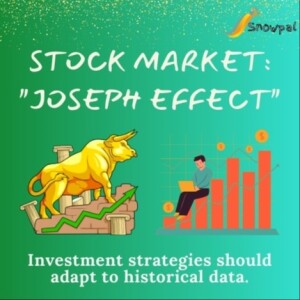
Wednesday Oct 16, 2024
Stock Market: "Joseph Effect"
Wednesday Oct 16, 2024
Wednesday Oct 16, 2024
In this episode, Krish Palaniappan discusses investment strategies, focusing on the Joseph Effect and its implications for future stock market returns. He explores historical patterns in the stock market, referencing Warren Buffett’s advice and the potential for below-average returns in the coming decade. The conversation emphasizes the importance of understanding market trends and adapting investment strategies accordingly.
Takeaways
The Joseph Effect indicates potential market downturns.
Historical stock market patterns reveal cyclical trends.
Warren Buffett’s advice remains relevant in today’s market.
Understanding market behavior is crucial for investors.
Investment strategies should adapt to historical data.
The stock market’s past can inform future decisions.
Long-term planning is essential for financial success.
Chapters
00:00 Introduction to the Podcast and Its Focus01:21 Exploring Investment Topics and Courses02:57 Understanding the Joseph Effect in Stock Market Returns09:36 Analyzing Historical Stock Market Patterns16:33 Implications for Future Investment Strategies
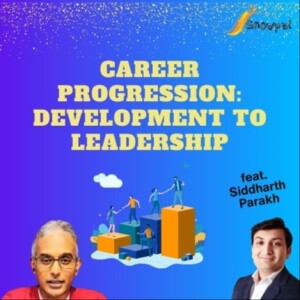
Tuesday Oct 15, 2024
Career Progression: Development to Leadership (feat. Siddharth Parakh)
Tuesday Oct 15, 2024
Tuesday Oct 15, 2024
In this episode, Krish Palaniappan engages with Siddharth Parakh, an experienced software engineer and leader, to discuss the evolving role of developers in the age of AI. Siddharth shares his journey from a developer to an engineering leader, emphasizing the importance of understanding the bigger picture in software development. The conversation explores the significance of user perspective, leadership in engineering, and the balance between customer needs and development priorities. They also delve into the dynamics between product owners and developers, the art of prioritization, and the concept of customer obsession versus innovation. They explore the nuances of customer obsession, innovation, and the iterative process of product development.
Takeaways
Understanding the user perspective enhances software development.
Leadership in engineering is about more than just coding.
Customer obsession is crucial for product success.
Balancing customer needs with development priorities is essential.
Effective communication between product and engineering teams is key.
Prioritization in software development requires understanding impact.
Every product team should allocate time for customer support activities.
Innovation should not overshadow the importance of customer satisfaction. Customer obsession is about delivering happiness, not just following demands.
Innovation often arises from solving personal needs, not just customer requests.
Agility in development allows for iterative improvements based on user feedback.
Failure is a crucial part of the innovation process; companies must embrace it.
Success traits include accountability, ownership, and a willingness to learn.
Cultural context can influence the startup environment and opportunities for networking.
Location can impact inspiration and motivation, but not individual performance.
Building software requires minimal resources, making it accessible to many.
Success is subjective and can vary based on personal goals and definitions.
Commitment and passion are essential for success.
You don't have to chase titles; focus on what you love.
Learning from others is crucial for growth.
Burning the back bridge helps you focus on your goals.
Nobody regrets doing something; they regret what they didn't do.
Sacrifices are necessary when building a business.
Chapters
00:00 Introduction to Siddharth Parakh's Journey
03:06 The Developer's Perspective: Understanding the Bigger Picture
05:57 The Importance of User Perspective in Software Development
08:45 Leadership in Software Engineering: Beyond Coding
11:52 Balancing Customer Needs and Development Priorities
15:11 Navigating Conflicts Between Product and Engineering
17:56 Role-Playing: Product Owner and Developer Dynamics
20:53 The Art of Prioritization in Software Development
24:07 Customer Obsession vs. Innovation: A Balancing Act
37:55 Customer Obsession vs. Innovation
40:48 Agility in Product Development
43:26 The Role of Failure in Innovation
46:09 Finding the Right Focus for Success
49:58 Common Traits of Successful Individuals
52:22 Cultural Differences in Success
57:35 The Impact of Location on Career Success
01:06:21 Overcoming Barriers to Entry in Tech
01:12:38 Discovering Strengths and Humility
01:14:39 The Journey of Commitment and Passion
01:17:33 Learning from Others and Embracing Growth
01:20:53 The Transition to Entrepreneurship
01:25:32 The Importance of Full-Time Commitment
01:31:17 Navigating Sacrifices in Entrepreneurship
01:35:31 The Value of Mentorship and Personal Insights
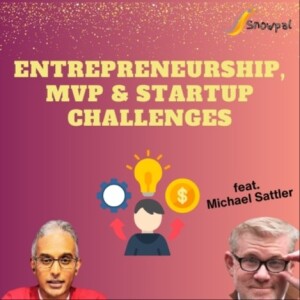
Monday Oct 07, 2024
Entrepreneurship, MVP & Startup Challenges (feat. Michael Sattler)
Monday Oct 07, 2024
Monday Oct 07, 2024
In this episode, Krish Palaniappan interviews Michael Sattler, a serial entrepreneur and fractional technical product executive. They discuss the critical aspects of MVP development for early-stage companies, emphasizing the importance of finding product-market fit, learning from failures, and the necessity of customer feedback. Michael shares his insights on the entrepreneurial journey, the value of teamwork, and the motivations behind starting a business. The conversation highlights the realities of entrepreneurship, the importance of continuous learning, and the need for realistic expectations in the startup world.
Takeaways
Learn more from failures than successes.
Finding product-market fit is crucial before building an MVP.
Customer feedback is essential in defining an MVP.
Entrepreneurship is a team sport, not a solo endeavor.
Motivation should be about solving problems, not just making money.
Working for a startup can provide valuable experience for aspiring entrepreneurs.
The myth of the solo entrepreneur can be damaging to new founders.
Realistic expectations are important for startup success.
Continuous learning is key in entrepreneurship.
Building a product should start with understanding customer needs.
Chapters
00:00 Introduction to MVP Development
03:14 Lessons from Startup Failures
06:03 Understanding Product-Market Fit
09:12 Defining the Minimum Viable Product (MVP)
12:04 The Importance of Customer Feedback
15:00 The Role of Founders in Startup Success
17:58 Navigating the Startup Landscape
21:05 The Value of Teamwork in Entrepreneurship
24:04 Motivation Behind Entrepreneurship
27:00 The Reality of Being Your Own Boss
29:47 The Myth of the Solo Entrepreneur
33:09 Learning from Experience
36:05 Advice for Aspiring Entrepreneurs
38:52 Closing Thoughts on Entrepreneurship

Thursday Oct 03, 2024
What does it take to build a (successful) business?
Thursday Oct 03, 2024
Thursday Oct 03, 2024
In this episode, Krish Palaniappan discusses the essential elements of entrepreneurship, drawing from personal experiences at Snowpal. He emphasizes the importance of patience, identifying real problems to solve, building a supportive network, and the need for self-motivation. The conversation also touches on the long-term commitment required in business, the significance of having expertise in your chosen field, and the critical nature of sales skills. Krish warns against the pitfalls of building products just because one can, urging entrepreneurs to focus on meaningful solutions.
Takeaways
Patience is crucial in building a business.
Identify a real problem that needs solving.
A strong support system is essential for success.
Expect to invest more time for less immediate pay.
Money should not be the primary motivator.
Self-motivation is key to overcoming challenges.
Entrepreneurship may not be for everyone.
Your business should align with your expertise.
Be prepared for a long-term commitment.
Sales skills are vital for entrepreneurial success.
Chapters
00:00 Introduction to Entrepreneurship
03:09 The Importance of Patience in Business
05:56 Identifying Real Problems to Solve
08:50 Building a Support System
12:14 Expectations of Time and Pay
15:09 Motivation Beyond Money
16:59 Self-Motivation and Resilience
19:10 Understanding Entrepreneurship is Not for Everyone
21:46 Expertise in Your Business Domain
24:09 Long-Term Commitment to Your Venture
25:48 Sales Skills and Experience
29:02 Avoiding the Trap of Building for the Sake of It
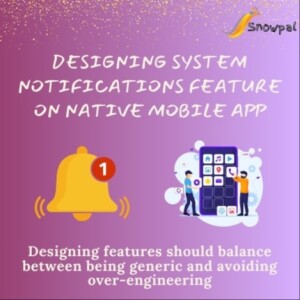
Tuesday Oct 01, 2024
Designing System Notifications feature on Native Mobile App
Tuesday Oct 01, 2024
Tuesday Oct 01, 2024
In this episode, Krish Palaniappan discusses the implementation of a specific feature in their mobile app, focusing on system notifications. He explains the different types of notifications, the design considerations for scalability, and the importance of creating a generic framework for future features. The conversation also touches on the managed services offered by Snowpal, emphasizing their commitment to helping clients achieve their software development goals.
Takeaways
The mobile app allows for 70-75% of web functionalities.
System notifications can be categorized into user and system notifications.
Designing features should balance between being generic and avoiding over-engineering.
Scalability applies to processes, teams, and methodologies, not just systems.
Using a JSON structure for notifications allows for easy updates without code changes.
Notifications must be intelligently managed to avoid redundancy for users.
Experience and skill sets of the team significantly impact project outcomes.
Managed services are offered to help clients with their software needs.
Effective communication of new features is crucial for user engagement.
The importance of a professional appearance in product development.
Chapters
00:00 Introduction to Snowpal and Mobile App Features
02:54 Exploring System Notifications
09:38 Designing Scalable Features
15:26 Managed Services and Conclusion
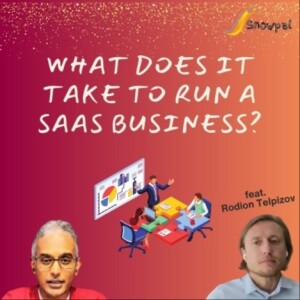
Monday Sep 30, 2024
What does it take to run a SaaS Business? (feat. Rodion Telpizov)
Monday Sep 30, 2024
Monday Sep 30, 2024
In this episode, Krish Palaniappan interviews Rod Telpizov, CEO of SmartJobBoard. They discuss the journey of launching and growing a SaaS business, the importance of choosing the right market, navigating business challenges, and the critical role of resilience in entrepreneurship. Rod shares insights on leveraging AI tools to enhance product offerings and provides advice for those looking to integrate AI into their software development processes. The conversation emphasizes the need for operational efficiency and the significance of identifying the best customer profile for sustainable growth.
Takeaways
Choosing the right market is crucial for success.
Operational efficiency and growth must be balanced.
Resilience is essential in navigating challenges.
AI tools can significantly enhance product capabilities.
Start small when integrating AI into your product.
Identifying your best customer profile is key to growth.
Niche markets can protect against larger competitors.
Building a network is vital for business success.
Adapting to market needs is necessary for survival.
Continuous learning and adaptation are essential in tech.
Chapters
00:00 Introduction to Smart JobBoard and Rod Telpizov
03:01 Launching and Growing a SaaS Business
06:06 Choosing the Right Market for Success
11:58 Navigating Business Challenges and Operational Efficiency
19:47 The Importance of Resilience in Entrepreneurship
24:03 Leveraging AI Tools for Competitive Advantage
30:10 Skills for Integrating AI in Software Development

Friday Sep 27, 2024
Product Management: Problems and Solutions (feat. Christoph Steinlehner)
Friday Sep 27, 2024
Friday Sep 27, 2024
In this episode, Christoph Steinlehner discusses the challenges faced by product managers, including endless discussion cycles and the importance of visual communication. He emphasizes the need for effective meetings, collaboration between product managers and developers, and the role of prototyping and user feedback in product development. Christoph also shares advice for aspiring product managers and reflects on common pitfalls in the field.
Takeaways
Product managers often struggle with endless discussion cycles in meetings.
Visual communication can significantly enhance understanding and collaboration.
Effective meetings should result in clear next steps and actionable outcomes.
Collaboration between product managers and developers is crucial for success.
Prototyping and user feedback are essential for validating product ideas.
Avoid being overly attached to initial product ideas; flexibility is key.
Understanding different perspectives in cross-functional teams can improve outcomes.
Start building projects to gain practical experience in product management.
Using visual tools can help clarify complex discussions.
Schnitzel is a beloved dish that represents Christoph's cultural background.
Chapters
00:00 Introduction to Product Management Coaching
02:29 Breaking Through Endless Discussion Cycles
05:56 The Role of Visual Communication in Product Management
14:07 Effective Meeting Strategies for Product Teams
18:22 Collaboration Between Product Managers and Developers
25:28 Prototyping and User Feedback in Product Development
33:01 Common Pitfalls in Product Management
42:18 Advice for Aspiring Product Managers
44:57 Closing Thoughts and Favorite Dishes







